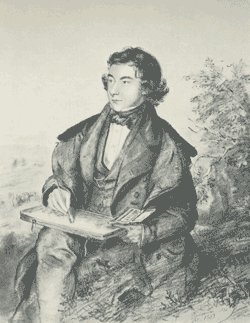James Moore, Amateur
(b. 1819, d. 1883)
Amateur
From A Dictionary of Irish Artists 1913

James Moore, Hon. R.H.A. Chalk drawing, by F. Piccione; in possession of Mr. F. A. C. Mills, Cliftonville, Belfast.
Was born in 1819. He studied medicine in Edinburgh, where he obtained his degree of M.D. in 1842, and in the same year qualified as a member of the College of Surgeons in London. He settled in Belfast where he pursued a successful career as a surgeon. In his student days in Edinburgh he became acquainted with many of the Scottish artists, among them Thompson of Duddingston, Erskine Nicol and Sam Bough, and commenced to draw and paint in water-colours, an art which he practised throughout his life with enthusiasm and with much ability and power. In his early days he did drawings for Syme's "Surgery." He was a brilliant sketcher from nature, and his work, almost always executed and completed on the spot, showed great power in depicting nature with truth and realism, and with a beauty and masterly style of technique. He was never without his colour-box and sketch-book, and utilized all his spare time wherever he might be in sketching landscapes and views which attracted him, and he had accumulated at his death a vast number of sketches and finished drawings. He did a number of sketches of old Belfast buildings. For many years his bold and vigorous landscapes were seen in the Royal Hibernian Academy, and in 1868 he was made an Honorary Member.
Moore was a man of kindly disposition concealed under a brusque manner and a somewhat affected roughness which rather repelled those who did not know and understand him. He died at his residence, 7 Chichester Street, Belfast, on 28th October, 1883.
His drawing of "Slieve Bernagh, Mourne Mountains," in the Belfast Art Gallery, is an example of the class of subject he had made his own. In 1907 a number of his drawings were exhibited in the Gallery, including: "Trassy Bog and Slieve Bernagh," an impressive mountain scene; "The Shimma River," "Earl's Bridge, Bryansford," a fine landscape in which the figures were put in by Erskine Nicol; "Lord Roden's Park, Tollymore"; "Straye's Bridge, Tollymore," an early work; "Newcastle Harbour," and "The Giant's Causeway," another early work.
